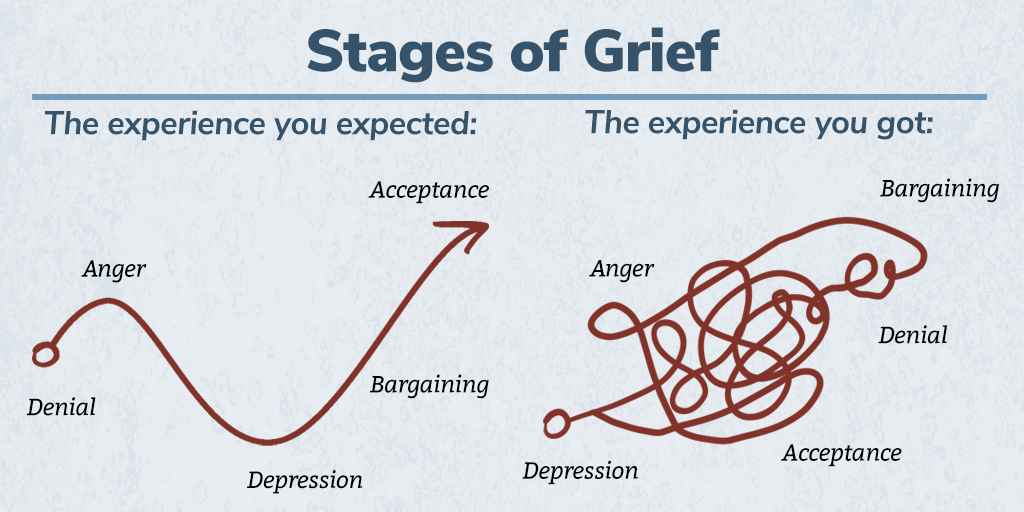September: Navigating the Grieving Process
The Month of September we are focusing on Loss and Suicide Prevention Awareness.
Are there stages of grief? Do we believe in them? Grief is not linear: it is up, down and all around. In this post we will discuss: Understanding the grieving process, stages of grief, coping strategies for navigating grief, talking about suicide.
Understanding the Grieving Process
While everyone’s journey through grief is unique, there are generally recognized stages that many people go through. It’s important to note that these stages are not linear and can overlap or occur in a different order for each person. There are many theories about the grieving process. We are going to focus on two: The Five Stages model & Worden’s Four Tasks of Mourning.
The Five Stages of Grief Model:
The five stages of grief model was developed by Elisabeth Kübler-Ross, and became famous after she published her book On Death and Dying in 1969. Kübler-Ross developed her model to describe people with terminal illness facing their own death. But it was soon adapted as a way of thinking about grief in general.
- Denial: Denial is often the initial response to loss. It may involve disbelief or a refusal to accept the reality of the situation. During this stage, individuals may feel numb or detached from their emotions.
- Anger: As the initial shock wears off, anger can emerge as a common emotion. It’s normal to feel anger towards the situation, towards oneself, or towards others. This anger is often a response to the pain and injustice of the loss.
- Bargaining: In an attempt to regain control or find meaning, individuals may engage in bargaining. This stage can involve thoughts of “what if” or “if only” as they try to negotiate with themselves, a higher power, or even the deceased.
- Depression: Depression is a natural part of the grieving process. It can manifest as feelings of sadness, hopelessness, or emptiness. It’s important to distinguish between normal grief-related depression and clinical depression, which may require professional assistance.
- Acceptance: Acceptance does not mean getting over the loss or forgetting about the person who is gone. It is about reaching a place of understanding and adapting to life with the absence of the loved one. Acceptance does not mean the absence of pain, but rather learning to live with it.

Worden’s Four Tasks of Mourning:
Psychologist J. William Worden provides a framework of four tasks that help us understand how people journey through grief. Healing happens gradually as grievers address these tasks, in no specific order, going back and forth from one to another over time.
| Task 1: To Accept the Reality of the Loss | Although you know intellectually that the person has died, you may experience a sense of disbelief. Integrating the reality of their death means “taking it in” with your whole being. For example, the reality may begin to set in immediately after the death, when you must call the mortuary, attend the memorial or pick up the ashes. Many weeks, months or years later when an occasion arises that they would have been part of, the reality again hits you as you realize that your dear one has died and they aren’t here to share these moments with you. |
| Task 2: To Process the Pain of Grief | Grief is experienced emotionally, cognitively, physically, and spiritually. People may be telling you: “Get over it; move on; be strong.” In contrast, one of the aims of grief support groups is to encourage and facilitate the safe expression of all the natural grief reactions. |
| Task 3: To Adjust to a World Without the Deceased | External adjustments include taking on responsibilities and learning new skills. Internal adjustments are made as you adapt to your new identity. Spiritual adjustments occur as you grapple with questions about your belief system and the purpose and meaning of life. |
| Task 4: To Find an Enduring Connection With the Deceased in the Midst of Embarking on a New Life |
Coping strategies for navigating grief or loss
Remember grief is a deeply personal experience, and there is no right or wrong way to grieve. However, there are coping strategies that can help individuals navigate their grief and find some sense of peace.
Here are five coping strategies that can be helpful during the grieving process:
- Seek Support from Others
- Practice Self-Care
- Express and Release Emotions
- Establish Rituals and Remembrance
- Find an outlet for your Grief
How to Support Someone Who is Grieving.
When a loss occurs, many people are caught between wanting to support the griever and handling their own discomfort. Some do this tightrope walk very well while others do not. Many do not know how to support someone than those who did. Here are guidelines about how one can truly support someone who is grieving:
- The Art of Listening – If only we listened with the intent to understand rather than to make our own selves heard, then the grieving process would go a lot smoother for many. So what do you say to someone who is grieving? First, nothing. Just listen. If you want to preface it with a supportive comment like – “I’m just here to listen.” – then go ahead. Sometimes all that’s needed is having the presence of another supportive human being.
- Helpful vs. Unhelpful Comments – What I have discovered is people really do want to be kind and helpful but often don’t know what to do or say, their comments are really meant to alleviate their own sense of discomfort rather than to offer support. Helpful Comments:
- “I’m so sad for your loss.”
- “I don’t know what you’re going through, but I’m here for you.”
- “What can I do to help?” – Be aware though that if you ask this question, you will have to be prepared to follow through. Don’t extend help if you don’t mean it.
- “Do you want to talk about it?” – Be okay with a ‘no’ answer.
- “Tell me more about (whatever the person is grieving).” – Be prepared for a ‘no’ answer.
- “Let me know what you need.” – Be prepared to follow through.
- Moving forward and finding meaning – Finding meaning in the face of loss does not mean forgetting or moving on from the person we have lost. Instead, it involves honoring their memory and finding ways to keep their spirit alive within us. It is about creating a new sense of purpose and finding ways to make their presence felt in our lives, even if they are no longer physically with us.
- One way to find meaning in loss is by connecting with others who have experienced similar grief. Sharing our stories, thoughts, and emotions with others who have gone through similar experiences can be incredibly healing.
- Another way to find meaning is by engaging in activities or practices that bring us joy and provide a sense of purpose. This can be anything from pursuing hobbies, volunteering for a cause that was important to our loved one, or engaging in acts of kindness in their memory. By finding ways to continue the legacy of our loved ones through our own actions, we can find a sense of purpose and fulfillment.
Finally, you can uncovering personal strengths: Rediscover purpose and hope
Uncovering personal strengths is a transformative journey that requires self-reflection, perseverance, and support. By reflecting on past accomplishments, identifying passions and interests, setting meaningful goals, seeking support and guidance, and practicing self-compassion and gratitude, you can rediscover your purpose and find hope for a brighter future.
Talking about Suicide
People dying by suicide is on the rise.
MYTH: Talking about suicide or asking someone if they feel suicidal will encourage suicide attempts.
FACT: Talking about suicide provides the opportunity for communication.
- Fears shared are more likely to diminish.
- The first step in encouraging a person with thoughts of suicide to live comes from talking about those feelings.
- A simple inquiry about whether or not the person is intending to end their life can start the conversation.
- However, talking about suicide should be carefully managed.
MYTH: Young people who talk about suicide never attempt or die by suicide.
FACT: Talking about suicide can be a plea for help and it can be a late sign in the progression towards a suicide attempt. Those who are most at risk will show other signs apart from talking about suicide. If you have concerns about a young person who talks about suicide:
- Encourage him/her to talk further and help them to find appropriate counseling assistance.
- Ask if the person are thinking about making a suicide attempt.
- Ask if the person has a plan.
- Think about the completeness of the plan and how dangerous it is. Do not trivialise plans that seem less complete or less dangerous. All suicidal intentions are serious and must be acknowledged as such.
- Encourage the young person to develop a personal safety plan. This can include time spent with others, check-in points with significant adults/ plans for the future.
